Starlink spring 2024, making sense of continued changes
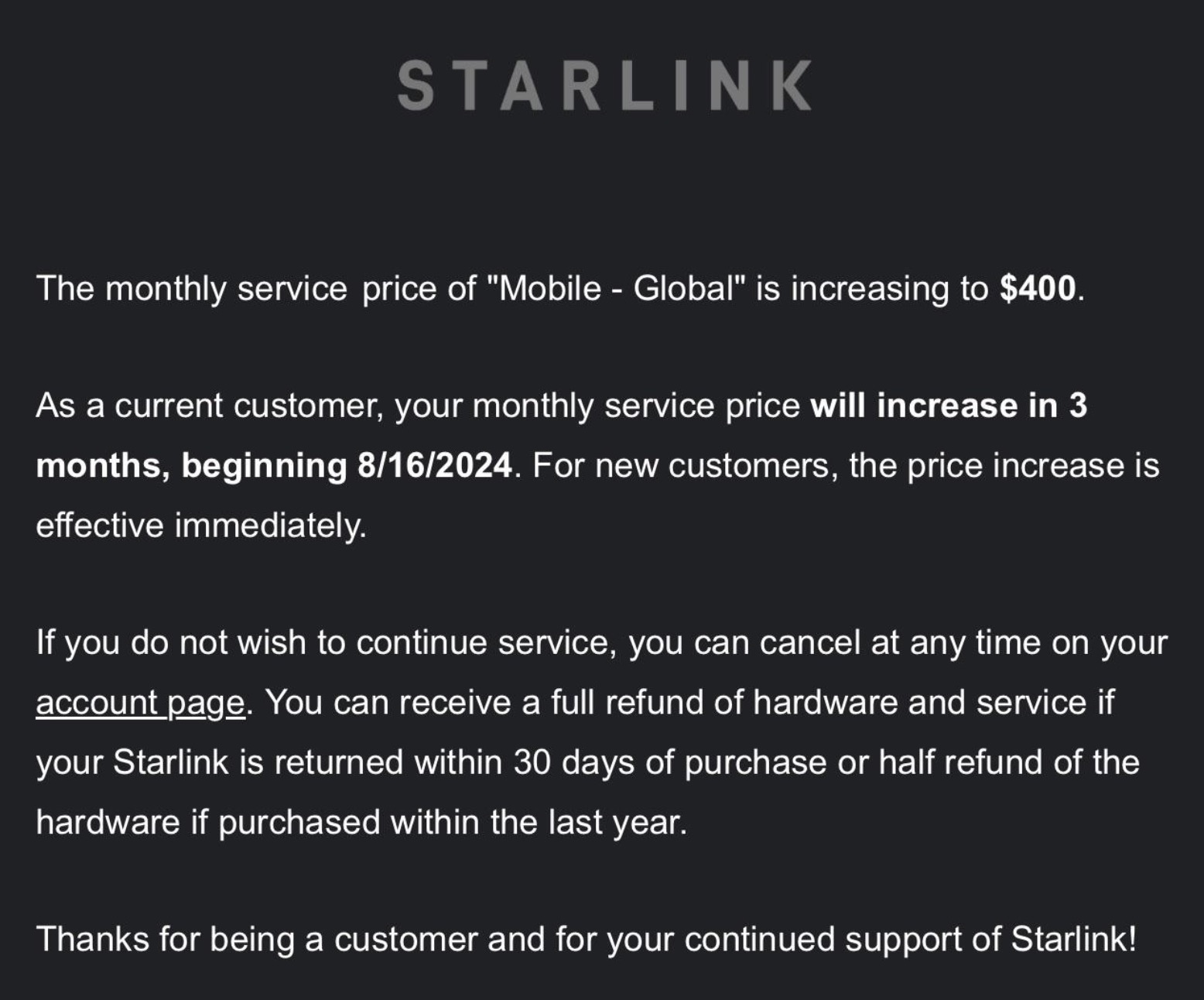
It’s been a little while since I’ve posted a Starlink update. Frankly, that’s because things have (mostly) been humming along pretty well with a relative minimum of changes. While there have been developments, including new hardware, none of them called to me for an update. Until last week. That’s when subscribers to Starlink’s Mobility – Global package received an email notifying them their monthly charges would double. So, now seems like a good time to dive back in and take a look at the state of affairs at SpaceX and Starlink.
For those who may be just joining us, or those who don’t pay quite as close of attention to these things as I do, here’s a quick rundown on Starlink. Starlink is the low-earth-orbit satellite internet subsidiary of SpaceX. SpaceX is a space exploration and communications company co-founded by Elon Musk. Musk’s fingerprints show through on much of how Starlink is run. SpaceX’s competitive advantage is their economical, reusable rockets and launch capabilities. This technology enabled SpaceX to launch over 6,000 of their low earth orbit satellites to deliver internet connectivity across the globe.
If you cover companies like this for a living, covering a company Musk runs is a headache. Most of the companies I work with have PR departments that can clear up confusion, give me a heads up when changes occur and generally work collaboratively to distribute accurate information. Not SpaceX and Starlink, I’m left trying to soak up as much as I can from social media, careful review of their terms of service, and a few friends in the industry. So, take everything I say here with a grain of salt; I don’t have access to the sort of information I usually do so there’s more speculation than I might like.
Plan changes
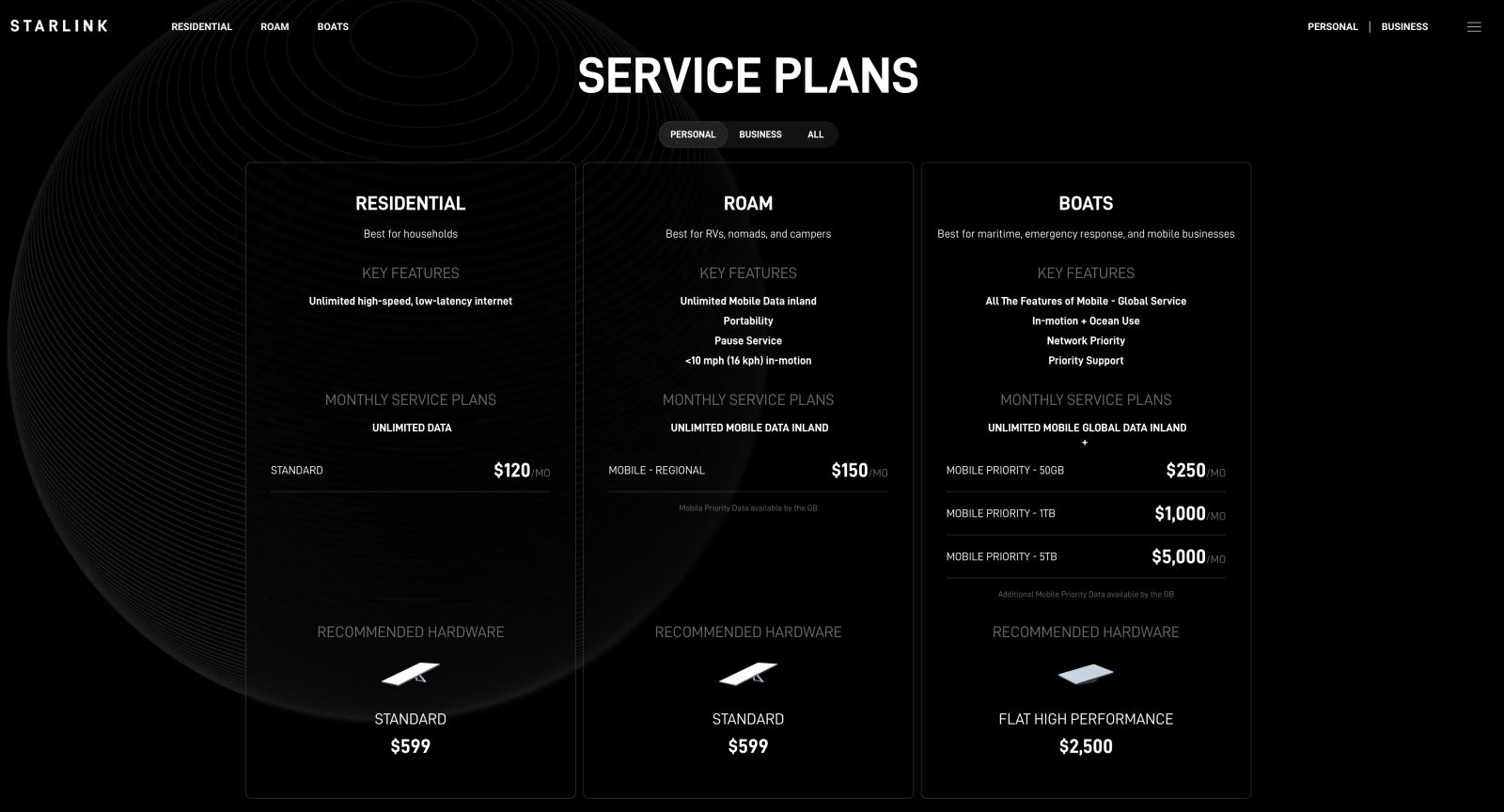
Starlink has used numerous names for their plans and that leads to some confusion. Starlink launched in early 2022 with a single plan and no add-ons. By May of 2022, a $25 per month Portability add on was introduced. Portability allowed using your terminal anywhere on your home continent. Next, they added an RV plan. The RV plan bypassed waiting lists for availability, promised only best effort service, and allowed suspending service for seasonal or occasional use. The RV plan came to be the plan of choice for boaters and hence many still know the plan that way. After RV, we got Maritime. Maritime was initially focused on commercial marine operations with $10,000 equipment and $5,000 per month service.
Nearly a year later, in April of 2023, Starlink began offering Maritime in more affordable packages. The most affordable of these packages offered 50 gigabytes of priority data (usable in motion at any speed as well as offshore) and unlimited inland and stationary data. At the same time, they reduced the equipment costs for these packages to $2,500. That made satellite delivered internet available anywhere in the world in motion or at rest attainable to many more boaters.
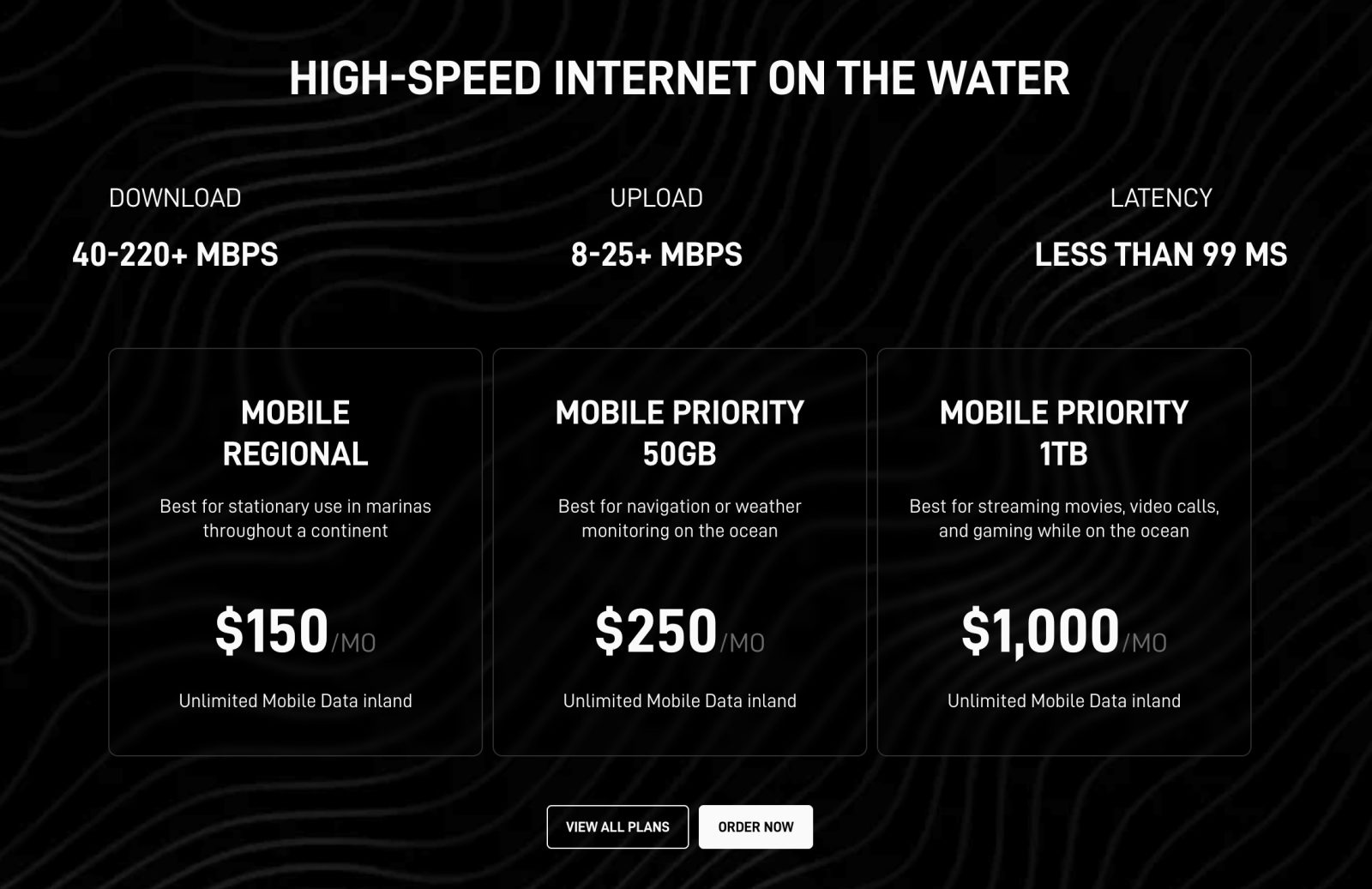
Since these major changes, the adjustments we’ve seen have been pretty minor. Packages have been renamed and moved around a bit and more clearly identified. These changes include the naming of Regional Roam and Global Roam to Mobile – Regional and Mobile – Global. Additionally, Maritime plans are now known as Mobile Priority plans. There’s also greater clarity that use of Starlink at speeds over 10 miles per hour requires the use of mobile priority data.
Mobile – Global price hike
Last week, subscribers to Starlink’s Mobile-Global package received notice that the cost of their plan would roughly double. There are two mobile plans: Mobile – Regional and Mobile – Global. Mobile – Regional works on your home continent and Mobile – Global works anywhere in the world Starlink has service. In the U.S., Mobile – Global currently costs $200 and will move to $400. Starlink offers their services in local currencies throughout the world. Although the cost of some packages varies from country to country, it appears most countries are currently paying roughly the equivalent of $200 to $250 U.S.. It also appears the new rates worldwide will double.
Initially, I found this price hike hard to understand and really concerning. For as long as Starlink has been around, there has been continuous change. But, until now, that change hasn’t changed the overall economics of the service. The initial $100 a month service quickly increased to $110 followed by add-ons for portability, another $10 increase to $120 a month, and more. But, we’ve never seen a 100% increase and frankly I found that increase concerning.
Mobile – Global probably represents a pretty small share of subscribers. For boaters who travel between continents, it provides the luxury of having connectivity wherever you may end up. But, it doesn’t provide coverage while you’re on the way, assuming that passage is offshore. So, I think many boaters who are willing to spend $200 (or thereabouts depending on local currency) may well be willing to spend $250 for Mobile Priority – 50GB and have the option of turning on data offshore.
A possible explanation?
The more I thought about this increase, the less sense it made to me. The increase of Mobile – Global raised that package’s cost to $150 more per month than Mobile Priority – 50GB, a rate plan that includes 50 gigabytes of priority data that can be used in motion, on the open ocean or to receive higher performance. So, either more price increases were forthcoming or for some reaons, they are really trying to make Mobile – Global unattractive. The more I thought about it, the more that was seeming likely. Especially when I noticed that Mobile – Global no longer appears in their service options.
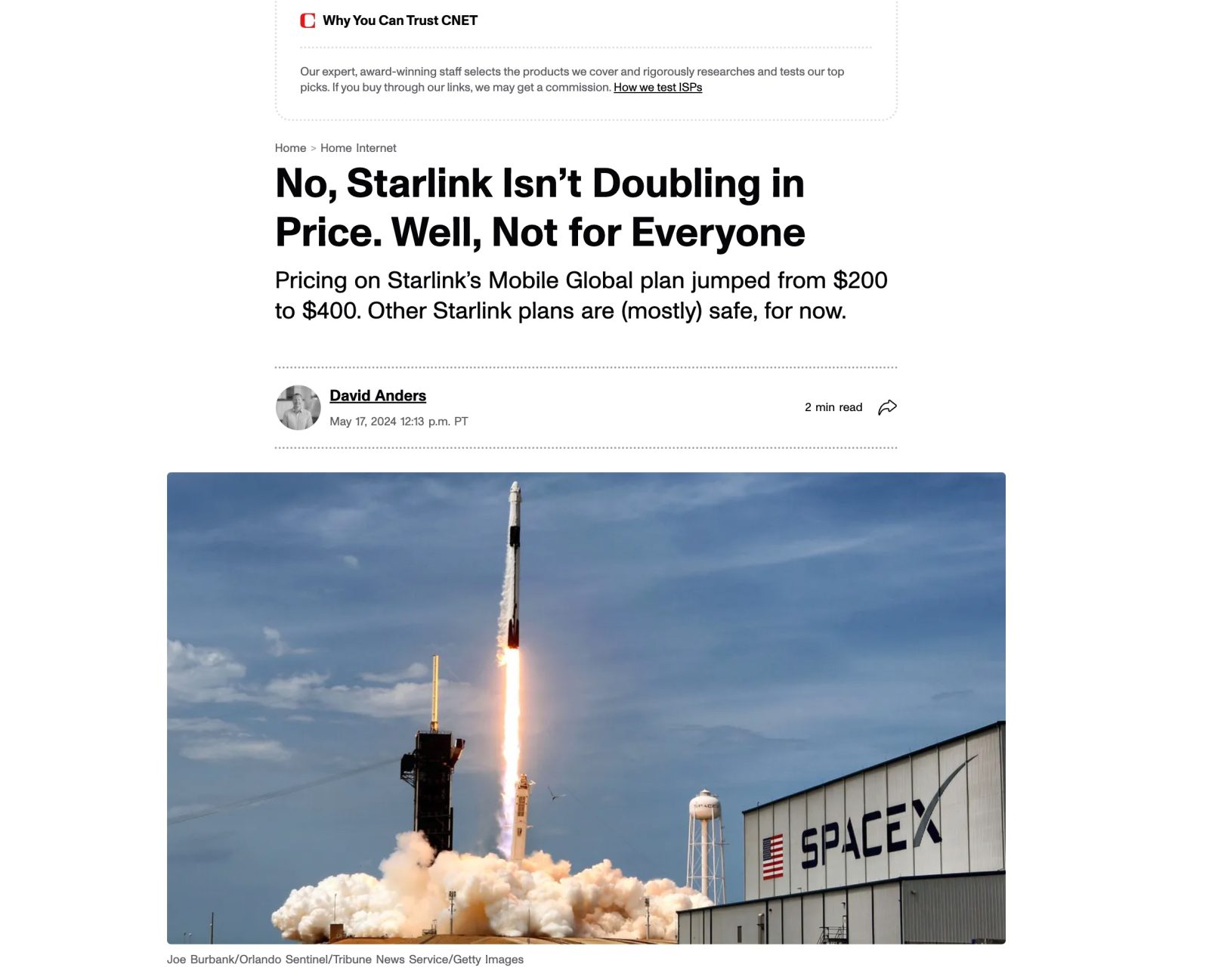
As I began thinking it was likely Starlink was simply trying to make the plan unattracitve, I came across an article from CNet. The title of the CNet article, No, Starlink Isn’t Doubling in Price. Well, Not for Everyone, is direct and to the point. David Anders, the CNet article’s author, doesn’t seem to have any more direct sources than I do. But, he’s reached the conclusion that this hike is all about this plan and not about overall rising prices.
As mentioned, there’s simply no one from Starlink I can contact to confirm or debunk my speculation. So, we’re all left to read the tea leaves and speculate. The more I’ve thought about this speculation, I think this theory of plan management is the best fit based on what we know.
Plans previously
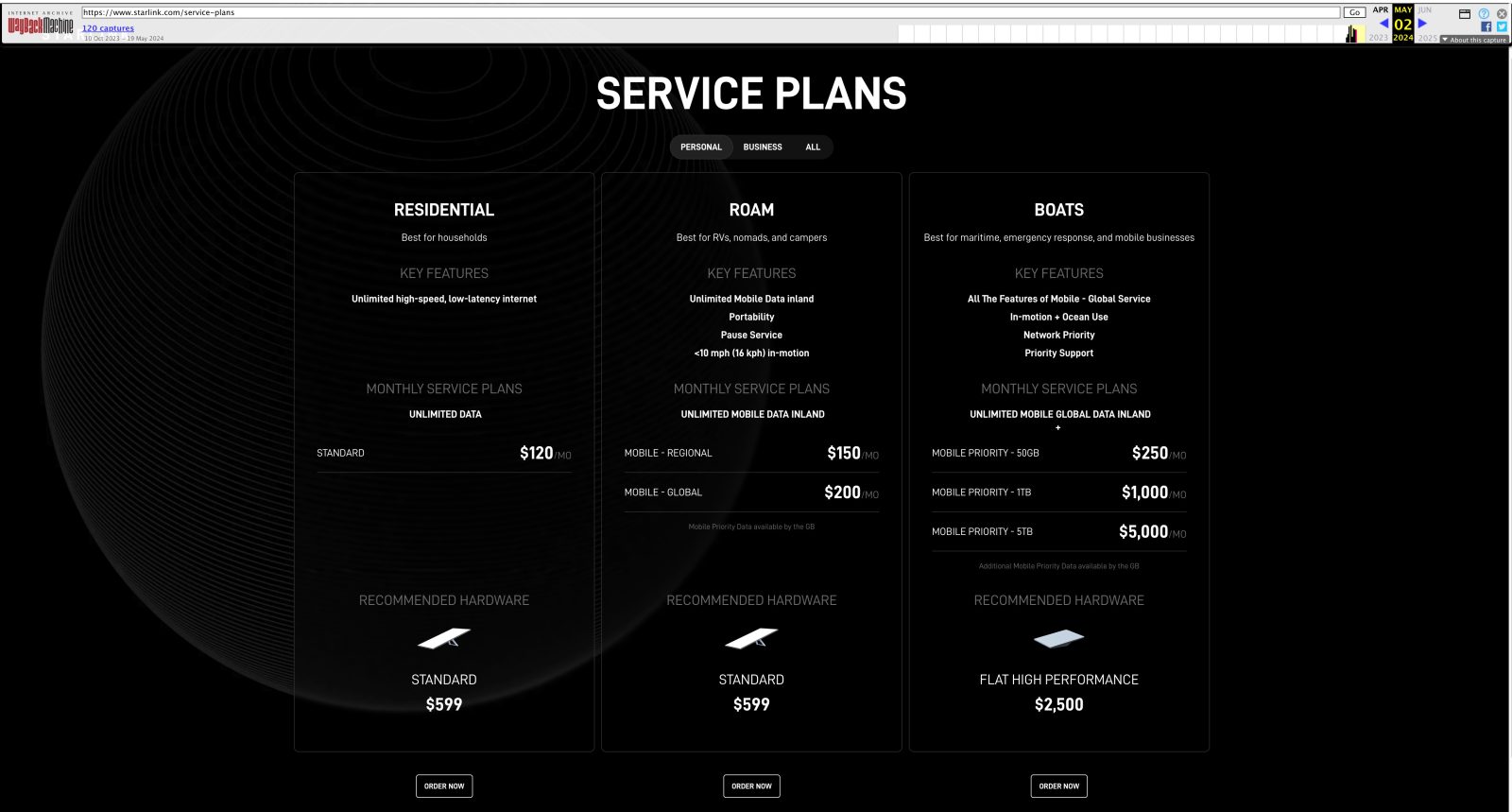
Sometimes the Internet Archive’s Wayback Machine comes in especially handy. The screenshot above is from the Wayback Machine and shows service plans as of May 2nd, 2024, including Mobile – Global. Until the recent changes, this is what the service lineup looked like: The cheapest service offering was residential for $120. A $30 increase in monthly cost got Mobile – Regional with service on land anywhere in your home continent. Another $50 increase from $150 for Mobile – Regional to $200 for Mobile – Global got you the same service anywhere in the world Starlink provided service. The next $50 increase to $250 per month bought Mobile Priority – 50GB. Mobile Priority – 50GB delivers the same features as Mobile – Global plus 50 gigabytes of priority data. Priority data allows use in motion over 10 miles per hour and in service areas deemed to be ocean.
The lineup now appears to delete Mobile – Global and moves right from Mobile – Regional for $150 to Mobile Priority – 50GB for $250 per month.
Priority data

The last time I wrote, we did not have clarity about how priority data consumption would work. I don’t have a Mobile – Priority subscription active, but it’s my understanding that included priority data is consumed first. So, if you have the Mobile Priority 50gb plan, the first 50gb you use will consume your priority allotment. Regardless of whether you’re inland or on open ocean, stationary or moving. That’s far from ideal. For occasional open water cruisers, it is unlikely they will line up their open water cruising to start on the first day of their billing cycle. So, there’s a strong chance they will end up having to buy priority data at $2 per gigabyte.
Two month limit
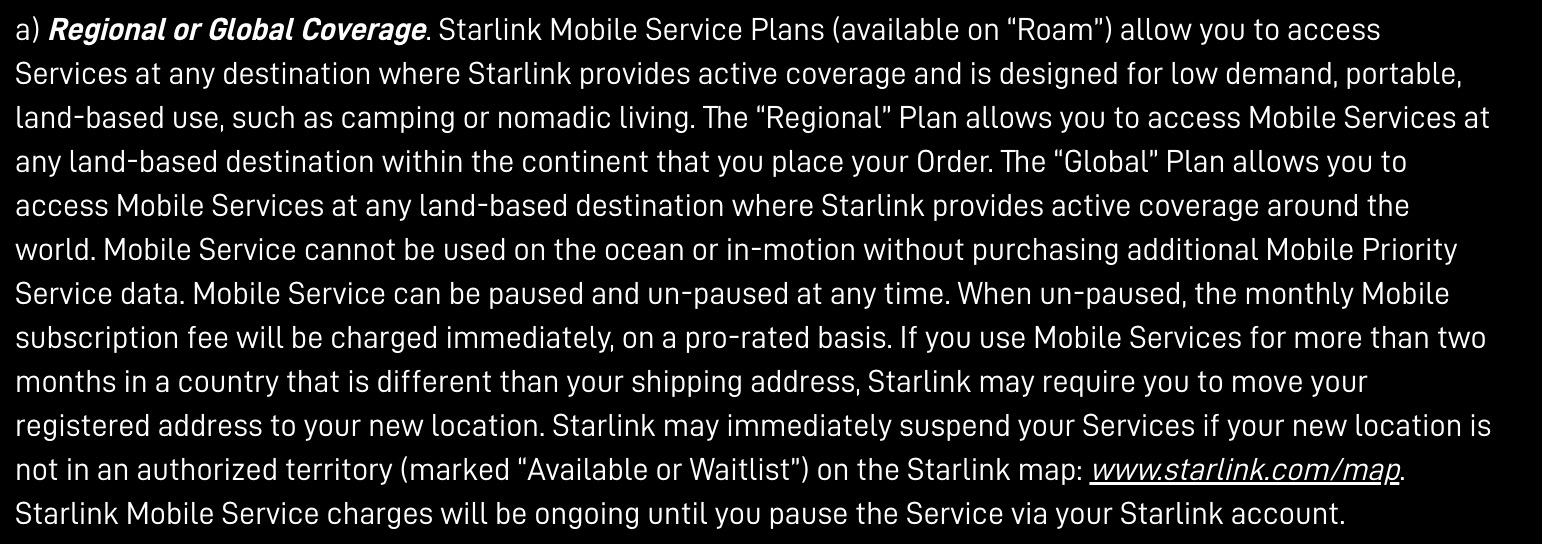
Both Mobile – Regional and Mobile – Global plans have always had a two month limit for use outside your home country. However, that limit hasn’t been enforced. In the last few weeks, several messages have popped up on Facebook Starlink groups detailing both communications from support and sudden suspension of service for those who have been out of their home country for more than two months. It seems they might be cracking down first on those who have been in countries where Starlink service isn’t currently available, but the reports are all anecdotal at this time.
New hardware

The biggest news since my last update is the new terminal. The third generation terminal is larger and simpler than the outgoing articulated terminal. Pricing remains at $599 including a WiFi 6 router and separate power supply. The terminal no longer articulates itself. Instead, it simply sits on the ground, propped up on its kickstand.
The generation 3 hardware delivers higher performance, has a larger field of view, and consumes more power. For those powering their terminal from an inverter, that last point might be a deal breaker. In my own testing, I’ve seen the generation 2 terminal consume between 30 and 60 watts with an average around 40 watt hours per hour. The generation 3 terminal consumes between 50 and 90 watts and seems to average about 65 watt hours per hour.
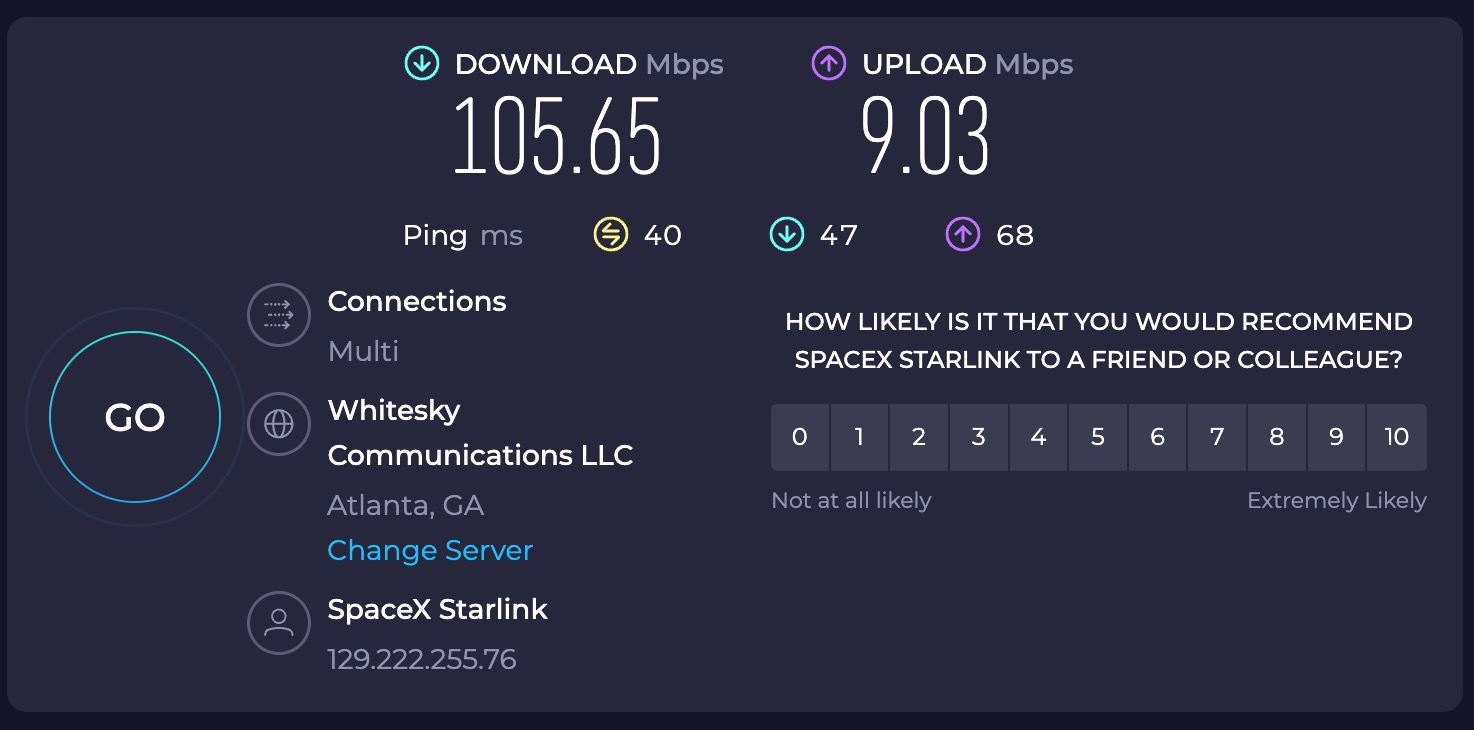
The gen 3 terminal is definitely faster than the gen 2 hardware. I’ve seen lots of articles referencing double the performance. In my own testing, I’ve seen probably closer to 50 percent faster but that leaves me with little to complain about. I typically see between about 75 megabits per second and 250 megabits per second. I’ve noticed significant variability based on time of day and location.
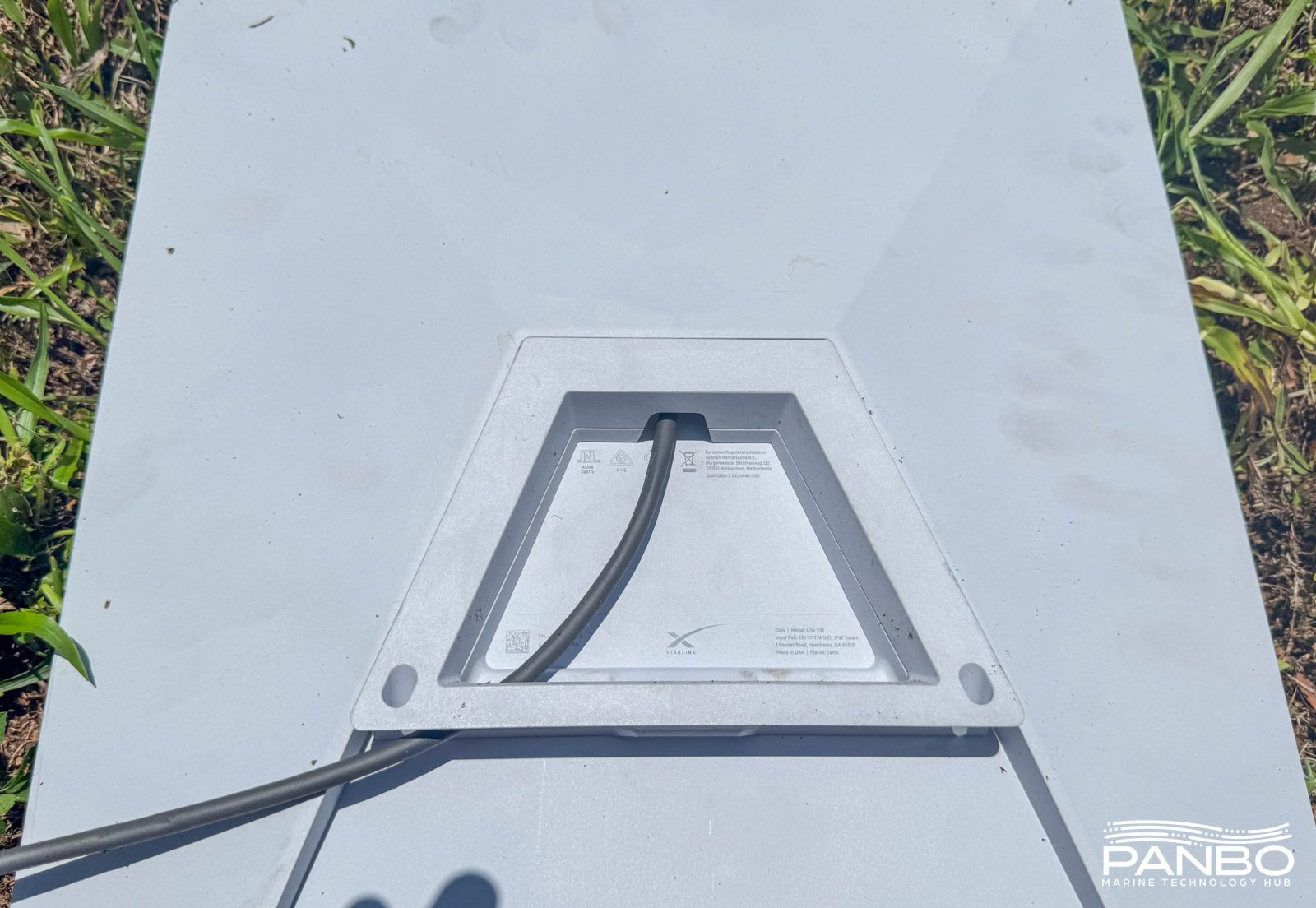
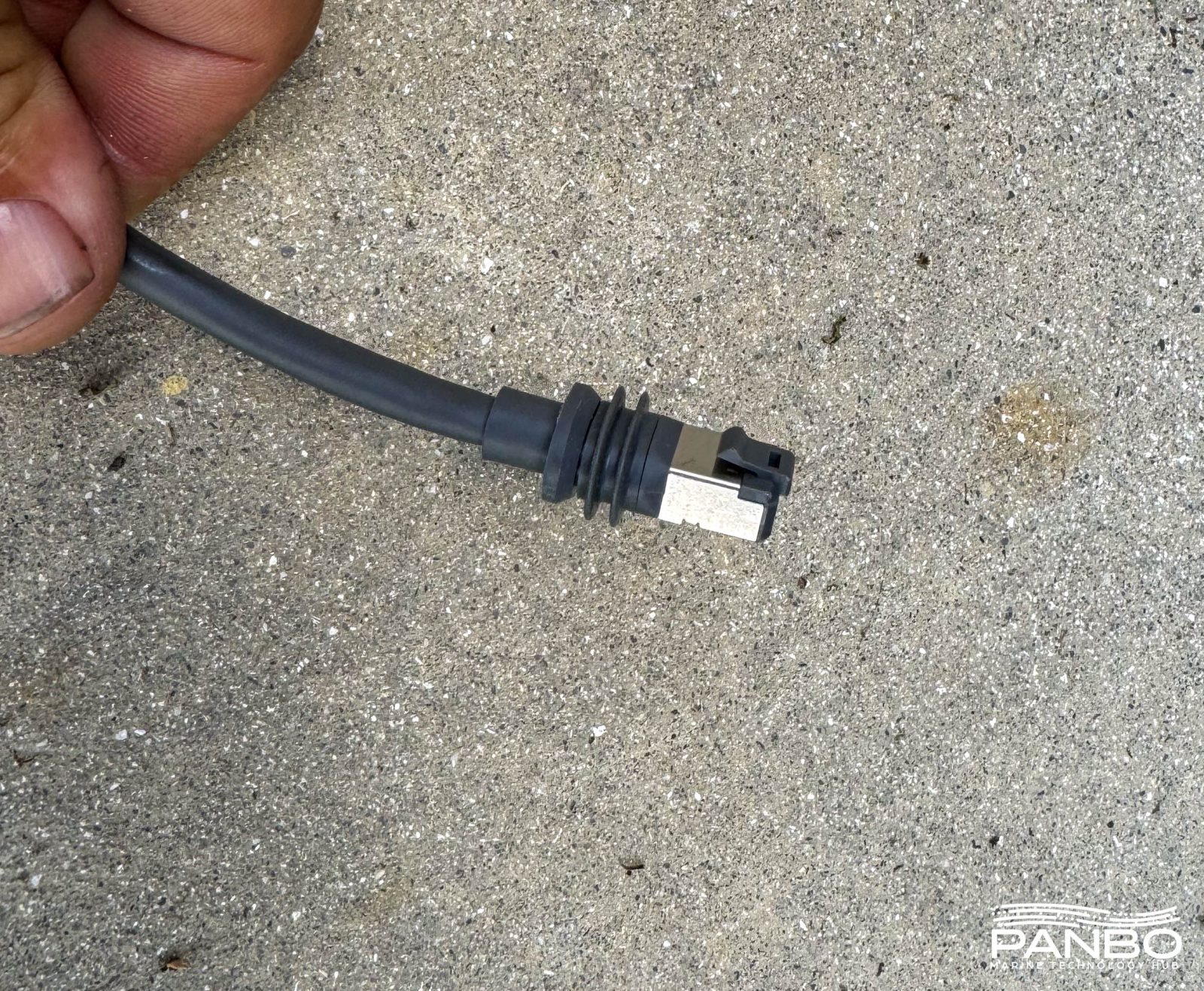
My understanding is that the main purpose of the kickstand on the back of the terminal is drainage. Also around back, we find a new connector and that’s big news. It appears the third generation hardware marks the end for the USB-C like connector used on previous generations. We now have a pretty standard looking RJ-45 connector without the locking tab of a typical RJ45. Instead of retaining the cable with the tab, the three weatherproofing flanges up the cable from the connector also provide friction to hold the cable in place. In my use so far, the cable has stayed put nicely and seems much less damage prone than the previous connector. I’ve read posts indicating a shielded RJ45 cable will work though the weather seal is questionable. That seems like great news should you find yourself in far flung regions with a damaged cable.
Mini terminal
It’s an open secret that Starlink is working on a mini terminal. Review of firmware, FCC filings, and some of SpaceX’s own statements confirm a mini is on the way. We don’t know the exact timing, but courtesy of the Mobile Internet Resource Center’s recent article, we do know that both the $599 standard generation 3 and mini terminals have received FCC approval for in motion use. I’m anxious to see the specs on the mini, particularly for power consumption. Will this be small enough to fit in a backpack and efficient enough to run off a small battery? If so, what kind of performance will it deliver?
High performance ditches the router
The last bit of hardware news is that $2,500 high performance flat terminal no longer includes a router with the bundle. This too was recently reported by the Mobile Internet Resource Center and they have more details. But, the basics are you now have the option to purchase a, higher performing than previously bundled, router from Starlink, or provide your own. Speculation is that many of the high performance buyers were using their own router anyways so this may not impact too many people.
Actuated gets a flat option in the app
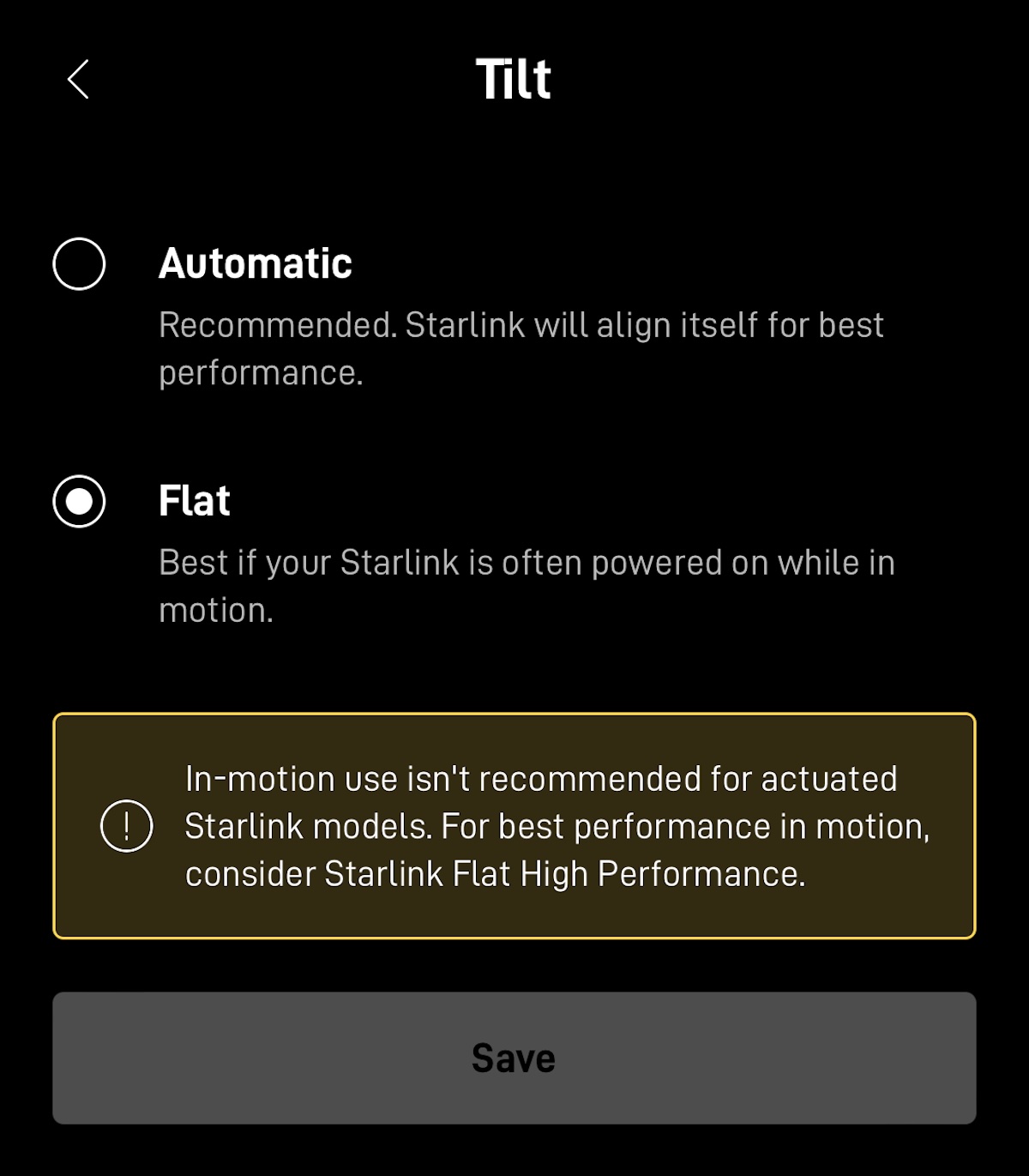
After several years of creative hardware modifications in order to disable the tilt motors in the actuated or gen 2 terminal, Starlink has quietly added an option to the app to lay it flat. My understanding is you must be on a rate plan that supports in motion use, so one of the Mobile Priority plans. Additionally, they still give the disclaimers they have for some time that the actuated terminal isn’t designed for use in motion.
Final thoughts
As has become commonplace for Starlink, a lot has changed since I last provided an update. But, at the end of the day, I don’t think those changes will have major impact on boaters. It is worth mentioning that several of my earlier Starlink entries haven’t aged well. So, you would be wise to treat my prognostications with skepticism. That said, Starlink continues to provide (relatively) affordable internet nearly anywhere on earth. That’s pretty remarkable and now well over two years into their services, they still have very little competition.


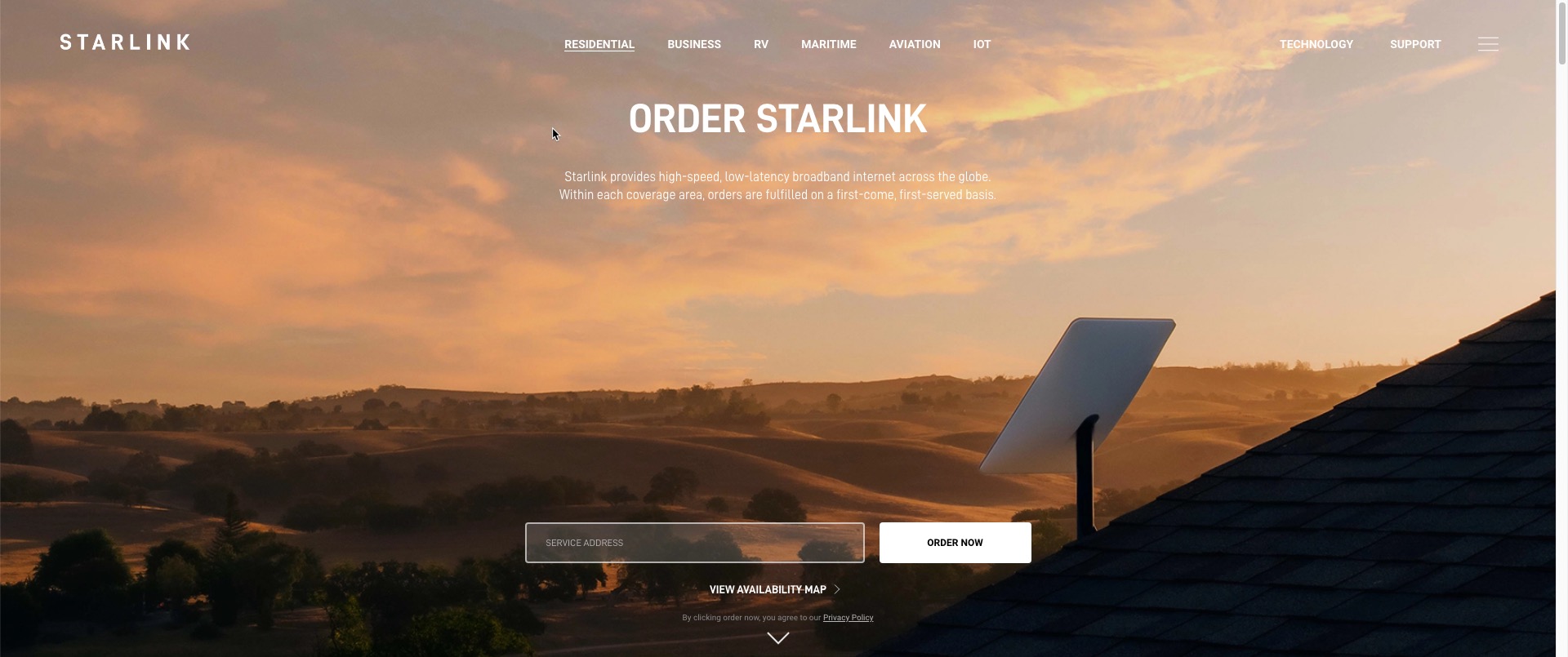

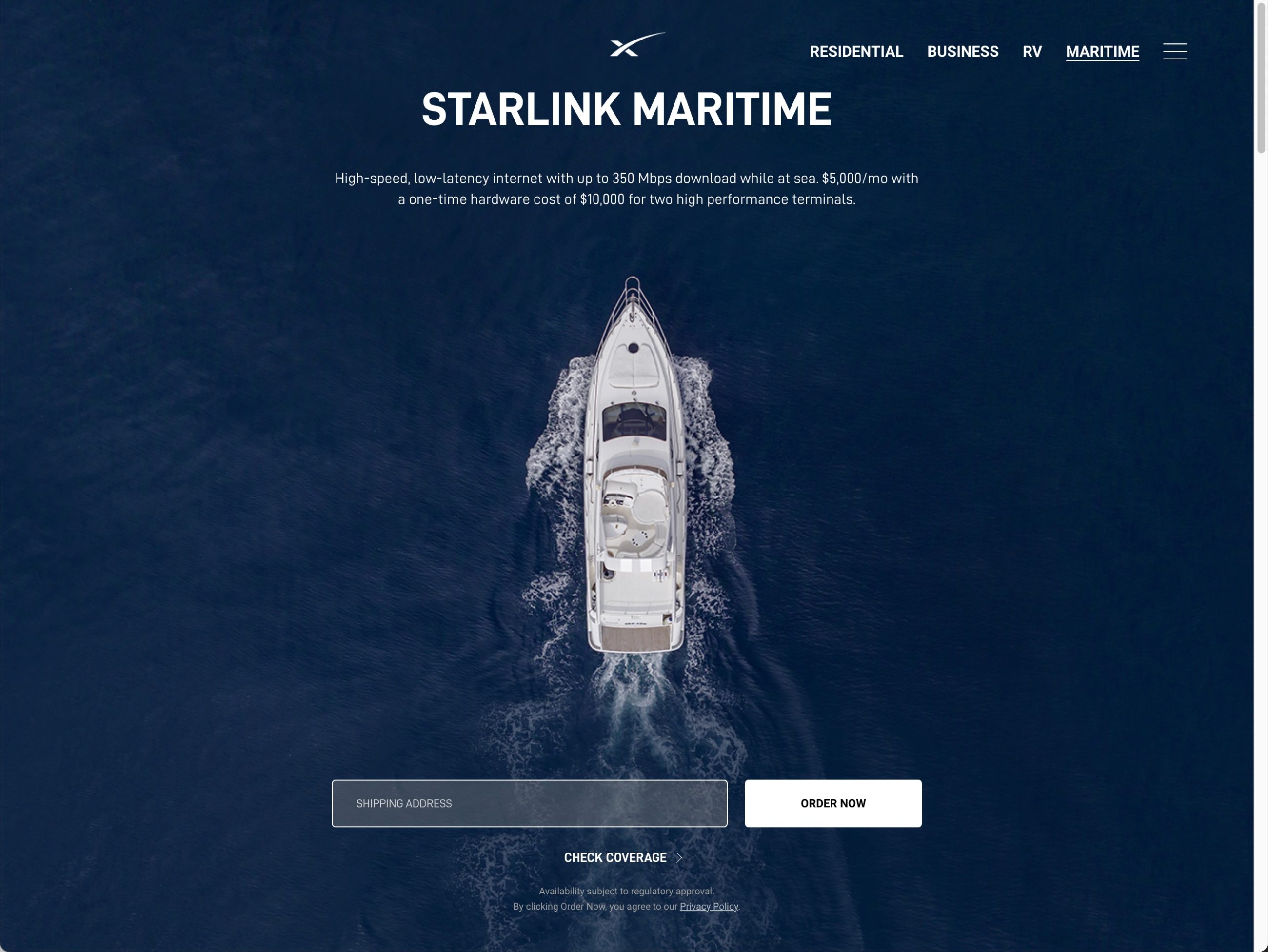
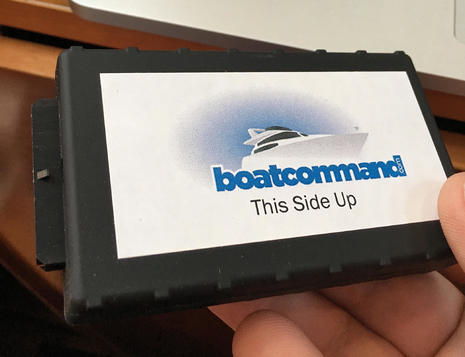







Ben-
I documented my installation of the Gen 3 Hardware on my trawler – on the blog section of my website (link below). I can confirm that laying it flat is problematic when it rains or mists as the unit puddles water and that does not work well at 13GHz. So if you fix mount it and won’t have easy access to the antenna to wipe off water, mount it at the 11degree kick stand angle. I also helped install a new 3rd Gen “standard” antenna on a Trawler Mast using the “House Mount” and that worked famously.
I routinely see very high data rates in the Pacific Northwest (Anacortes, WA – San Juan Islands) that exceed your results – I suspect that is due to the higher population density of the East Coast and with the expected higher simultaneous demand for bandwidth and data.
We have friends currently cruising in Alaska (Inside Passage from Anacortes starting point) Newtradition.blog, who are using the older “Actuated” version of Starlink on the Mobile Regional Plan with no problems. They never exceed 9Kts so that matches the Starlink stated limitations. At one point in their journey North, preparing to round Cape Caution, BC Canada, they were anchored with 8 other boats, every one of them had Starlink installed. Around here we run out of Cell coverage very fast when heading North into cruising country. Very little infrastructure at all really, so having a relatively affordable form of SATCOM available is very, very important.
We have also used our Starlink 3rd Gen “Kick Stand” hardware underway locally at less than 9Kts also with excellent results. We will be using the system for weather forecasts and communications for a trip to Desolation Sound / Discovery Islands and can report on that experience.
I can say that the new WIFI 6 Router has excellent range and has worked for me while on a dinghy with my phone a decent distance from the boat. Other friends have made the same report.
I do hope that your conclusion about “encouraging” users to leave a particular plan and move to the other Mobile plans is correct. Doubling prices per month on the Mobile / Roam / Regional Plan would be a huge negative impact to long distance trawler cruisers in this part of the country. We have to carry Bear Spray to take a walk in these parts!
WRT the MINI terminal, that will move from Ka Band (13GHz) to the MMW bands in the high 20-30GHz range where Starlink has licensed bands to use for their systems. When you double the operating frequency the antenna area for the same number of phased array elements is also cut in half. By keeping the same number of active array elements, power is not reduced – but may actually increase slightly because the devices that operate near 30GHz can’t use as many low power silicon devices (SiGe) and must switch to GaAs at least on the transmit side.
Propagation losses at the higher frequencies is higher and therefore bad weather will cause drop outs and reduced data rates more frequently. The MINI has the potential to accommodate many more users and provide better throughput in higher population density areas. I’ve been really impressed with the technology of the Starlink Antenna – combining a transmit and receive aperture that operate at different frequencies (Uplink data is transmitted at a higher band than Downlink data) using Dual Circular polarization is not a small thing!!
It remains to be seen how the competing system being developed at Project Kuiper (Amazon) will implement their system components and what performance they will achieve. If indeed Kuiper goes live in the next year or two and draws significant subscribers, then competition will act to help keep monthly fees and hardware costs down. Until another LEO system is operational, Starlink can set its own terms, but that has a limited horizon if Kuiper gets off the ground soon.
My Starlink installation blog is here: https://vacantisw.com/2024/01/23/starlink-new-standard-installation-on-a-trawler
Sorry to add that the Russians have figured out how jam Starlink:
https://www.nytimes.com/2024/05/24/technology/ukraine-russia-starlink.html?unlocked_article_code=1.uU0.MCh8.wtPOB-2_R8-e&smid=nytcore-ios-share&referringSource=articleShare
On our side of the Atlantic, the Mobile-Global plan has simply disappeared. Mobile-Regional stands at 59€ (Inc.VAT) and Mobile Priority- 50 GB at 287€ (Inc.VAT) with both additional Mobile Priority data at 2.29€/GB.
Thanks for the timely update. I have a regional roam plan but would consider the 50gb priority plan if starlink would provide a toggle so users can determine when to use their priority data. It’s illogical to force a user to consume their priority data first when onshore can should be able to use unlimited best efforts data. Hopefully starlink will see the shortcomings in this plans inability to toggle the priority data.
Getting rid of global is just weird though. Roam Global ($200) and 50GB Mobile Priority ($250) were identical minus the 50GB initial data. You could even think of Roam Global as 0GB Mobile Priority. Especially given on how dumb data access works it was ideal option. It is also weird they doubled the price instead of just saying it isn’t available and by default you will be bumped to MP 50GB unless you choose another plan. Then again SpaceX has always kinda just done stuff which was confusing and poorly explained so maybe par for the course.
Our friends at MIRC are quite disappointed with the initial Starlink Mini offering…
https://www.rvmobileinternet.com/starlink-mini-launched-disappointing-mini-roam-data-plan-dashes-nomadic-dreams/
…but the hardware tentatively looks good for even modest size cruising boats and this is only the ‘preliminary’ launch